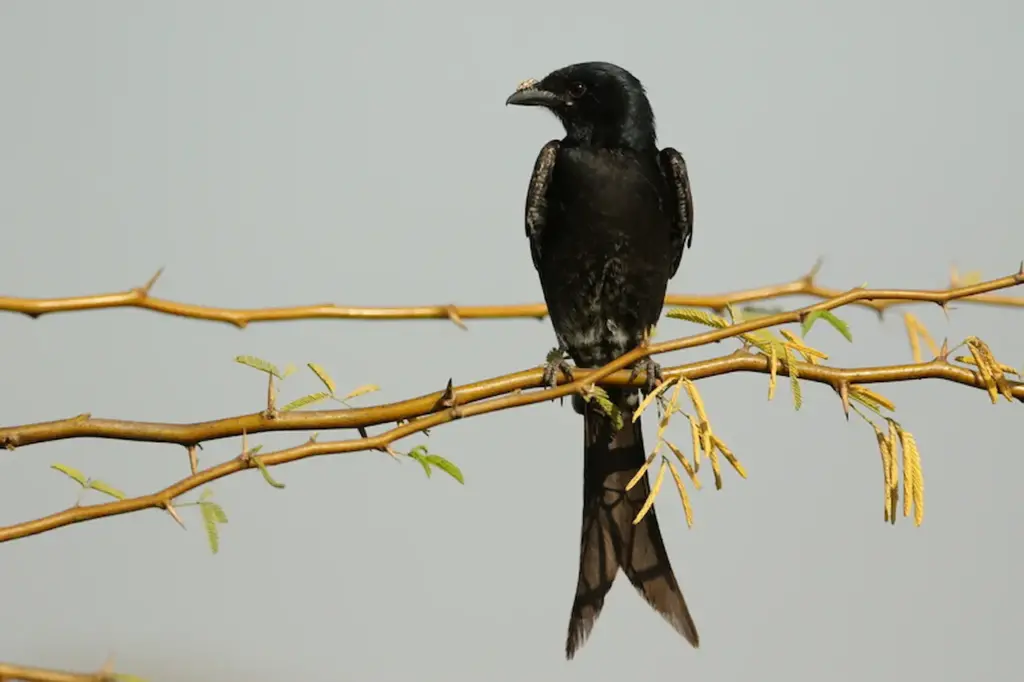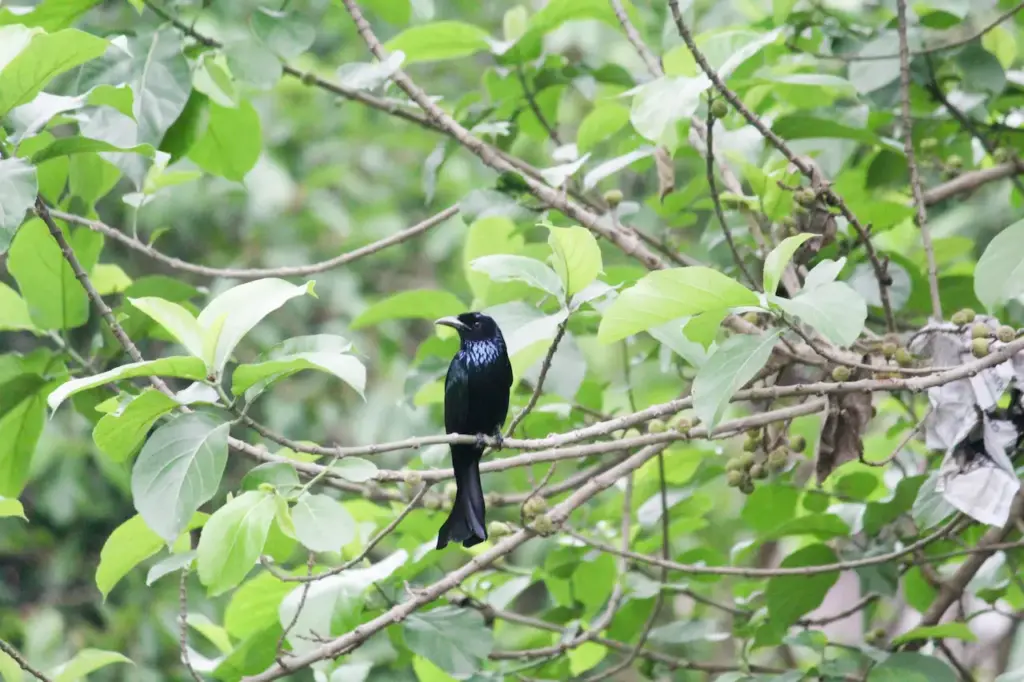Drongos
Drongos
The drongos are small birds that occur naturally in the Old World tropics (Africa, Asia, Australia) where they are found in open forests or bush.

The word “Drongo” is Australian slang for “idiot” – which may refer to this bird’s comical behavior.
They mostly feed on insects, small birds and occasionally, small skinks.
Some are amazing mimics that are able to learn the sounds heard in their environment, weaving them into ther own, impressive songs.
Description
The drongo’s plumage is mostly black or dark grey – sometimes with metallic tints.
They have long forked tails, and some Asian species have elaborate tail decorations.
Drongos have short legs and sit very upright whilst perched, like a shrike.
Diet / Feeding
They catch insects in mid-air or pick them or pick them up from the ground.
Nesting / Breeding
The nest is tpically located high in a tree. The average clutch consists of two to four eggs.
Nesting drongos are aggressive and fearless birds and will attack much larger species if their nest or young are threatened

Species of Dicruriniae
- Square-tailed Drongos, Dicrurus ludwigii – Occur in much of Africa south of the Sahara.
- Shining Drongo, Dicrurus atripennis, (Lower risk (lc)) – found in Cameroon, Central African Republic, Republic of the Congo, Democratic Republic of the Congo, Ivory Coast, Equatorial Guinea, Gabon, Ghana, Guinea, Liberia, Nigeria, Sierra Leone and Togo.
- Fork-tailed Drongo, Dicrurus adsimilis – Common and widespread in Africa south of the Sahara
- Príncipe Drongo, Dicrurus modestus (Lower risk (nt)) – Found on the island of Bioko and mainland west and central Africa from Guinea east to western Kenya and south to Angola.
- Aldabra Drongo, Dicrurus aldabranus, (Lower risk (nt)) – Found on the island of Aldabra (part of the Seychelles)
- Comoro Drongo, Dicrurus fuscipennis, (Endangered) – Found on the island nation of Comoros located .in the Indian Ocean, located off the eastern coast of Africa.
- Crested Drongo, Dicrurus forficatus, (Lower risk (lc)) – Found on the island nation of Comoros, and the islands of Madagascar and Mayotte.
- Mayotte Drongo, Dicrurus waldenii, (Endangered) – Endemic to Mayotte located in the Indian Ocean, between northwestern Madagascar and northeastern Mozambique.
- Black Drongo, Dicrurus macrocercus – Found in tropical southern Asia from southwest Iran through India and Sri Lanka east to southern China and Indonesia.
- Ashy Drongo, Dicrurus leucophaeus – Found across South and Southeast Asia.
- White-bellied Drongo, Dicrurus caerulescens – Found in India, Nepal, Bangladesh and Sri Lanka, South Asia.
Crow-billed Drongo, Dicrurus annectans, (Lower risk (lc)) – Found in Bangladesh, Bhutan, Brunei, Cambodia, China, India, Indonesia, Laos, Malaysia, Myanmar, Nepal, the Philippines, Singapore, Thailand and Vietnam.- Bronzed Drongo, Dicrurus aeneus – Found in the forests of the Indian Subcontinent and Southeast Asia
- Lesser Racket-tailed Drongo, Dicrurus remifer, (Lower risk (lc)) – Found in the Indian Subcontinent and Southeast Asia, ranging across Bangladesh, Bhutan, Cambodia, India, Indonesia, Laos, Malaysia, Myanmar, Nepal, Thailand and Vietnam. Inhabit subtropical or tropical moist montane forests.
- Hair-crested Drongo, Dicrurus hottentottus, (Lower risk (lc)) – Found in India and Bhutan through Indochina to China, Indonesia and Brunei.
- Balicassiao, Dicrurus balicassius, (Lower risk (lc)) – Found in the Philippines.
- Sulawesi Drongo, Dicrurus montanus, (Lower risk (lc)) – Endemic to Indonesia.
- Sumatran Drongo, Dicrurus sumatranus, (Lower risk (nt)) – Endemic to Indonesia.
- Wallacean Drongo, Dicrurus densus, (Lower risk (lc)) – Found in Indonesia and East Timor.
- Ribbon-tailed Drongo or Paradise Drongo, Dicrurus megarhynchus, (Lower risk (lc)) – Endemic to Papua New Guinea
- Spangled Drongo, Dicrurus bracteatus, (Lower risk (lc)) – Found in Australia.
- Andaman Drongo, Dicrurus andamanensis, (Lower risk (lc)) – Endemic to the Andaman Islands of the Indian Ocean.
- Greater Racket-tailed Drongo, Dicrurus paradiseus – Range extends from the western Himalayas to the eastern Himalayas and Mishmi Hills in the foothills below 4000 feet; into into the west to the islands of Borneo and Java in the east through the mainland and islands.


Hi All
My name is Karen and I live in North Qld, Australia. A pair of Spangled Drongos adopted us. We feed Magpies daily and the male came to visit for food every day, several times a day. We loved having his company and soon found out he’s a bit of a character! They are fascinating to watch how they swoop to catch food and so very quick. We believe he had chicks in the nest and we were relishing the day he would bring his family by. Alas, he suddenly disappeared. He has not been by for a week now which is strange. I pray nothing terrible has happened to them. Keep up the good work. Cheers